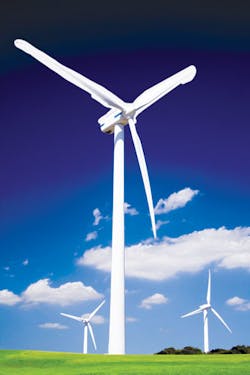The goal is to have 30 percent of our energy from wind by 2020. With this lofty goal in mind, many control systems integrators have developed their expertise to help serve this market. From integrating into existing supervisory control and data acquisition (SCADA) systems, to custom programming for scheduling purposes, and network and communication design, wind farms provide an ideal arena for companies to use integrator expertise.
Wind farms are primarily built across thousands of acres of open land, resulting in substations located several miles from each other in remote areas. There is an abundance of information available from the wind turbines and the power that they generate. It’s important that the information from the farms and substations be viewable and controllable from one main location. In addition, there are typically numerous entities, such as the wind farm owner, the operator, the local utility and utility authorities, who require access to some or all of the information. In an effort to accommodate this level of complexity in the SCADA environment, a combination of fiber, dial-up, wireless radio and frame relay networks are used.
Databases are often constructed to collect information about the turbines and the power generated. The data are sent to scheduling authorities and others to determine the best use of the wind-generated power. Custom programs are needed to collect and distribute the information about the power generated by the wind farm for scheduling and reporting needs. The data are retained in the database for reporting and can be sent in numerous file formats.
*****************************************************************Energy Management Content -
Gary Mintchell's Feed Forward Blog
http://bit.ly/aw_jimpinto
*******************************************************************
For wind farms without a 24/7 operator, there is no one to respond to the events, resulting in financial penalties to the generating entity. In one solution example, a “Limit-to-Schedule” program was developed using a ControlLogix programmable controller from Rockwell Automation Inc., the Milwaukee-based automation giant, with hardwired input/output, Modbus connection to the wind farm network and a small human-machine interface (HMI). The wind-farm management system receives the signal, reports current outputs and an e-mail event notification is sent to the wind-farm operator.
Communications
Overall communication architecture and network systems usually involve numerous protocols and hardware standards. Network switches and routers must be configured for secure communications between parties, and require an exchange of data that is monitored at each location. Internet Protocol (IP) phones connect over the network, allowing communications among several SCADA buildings, substations, and operations and maintenance buildings. Alarms send out and respond via cellular SMS (Short Message Service) messages and e-mail alerts. A network management package monitors the overall health of the system.
Wind energy requires support systems to continue to evolve and develop new technologies to ensure that the power generated will be used in the most efficient way. Integrating into the SCADA infrastructure, creating reporting tools and designing communication networks are all integral variables of supplying wind farms the tools necessary to ensure that this is exactly what happens.
Trisha Jones, [email protected], is the Client Relations Manager at Industrial Automation Consulting Inc., in Three Forks, Montana.
Subscribe to Automation World's RSS Feeds for Columns & DepartmentsAbout the Author
Trisha Jones
Industrial Automation Consulting

Leaders relevant to this article:
